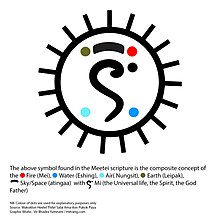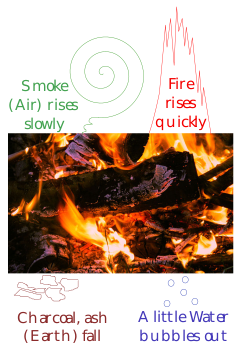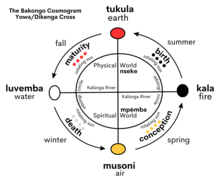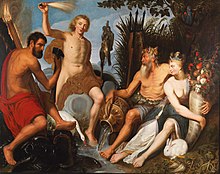Cantore Arithmetic is able to discern death to an element: De is at addition to the subtract punctuation to gain a shape as a figure!!
D is A horizontal row in the periodic table. One period now e Fluorine is new to the mc square as the element is a letter to a note in Mozart’s Magic Flute by score to the Alice of The Brady Bunch!!
The heart of the matter: Matter element is classical: Polo is a square and the horse is a bridle to the saddle of the girth as a cinch is Western to the rider in the storm of what is a category!!
Category; as in type
one of the units into which a whole is divided on the basis of a common characteristic
divide the essays into categories based on difficulty of comprehension
Psalms 90:10
“The days of our years are threescore years and ten; and if by reason of strength they be fourscore years, yet is their strength labour and sorrow; for it is soon cut off, and we fly away.”
King James Version (KJV)
now a heart
Classical element


| Classical elements |
|---|
The classical elements typically refer to earth, water, air, fire, and (later) aether which were proposed to explain the nature and complexity of all matter in terms of simpler substances.[1][2]Ancient cultures in Greece, Tibet, and India had similar lists which sometimes referred, in local languages, to "air" as "wind" and the fifth element as "void".

These different cultures and even individual philosophers had widely varying explanations concerning their attributes and how they related to observable phenomena as well as cosmology. Sometimes these theories overlapped with mythology and were personified in deities. Some of these interpretations included atomism (the idea of very small, indivisible portions of matter), but other interpretations considered the elements to be divisible into infinitely small pieces without changing their nature.
While the classification of the material world in ancient India, Hellenistic Egypt, and ancient Greeceinto air, earth, fire, and water was more philosophical, during the Middle Ages medieval scientistsused practical, experimental observation to classify materials.[3] In Europe, the ancient Greek concept, devised by Empedocles, evolved into the systematic classifications of Aristotle and Hippocrates. This evolved slightly into the medieval system, and eventually became the object of experimental verification in the 1600s, at the start of the Scientific Revolution.[4]
Modern science does not support the classical elements to classify types of substances. Atomic theory classifies atoms into more than a hundred chemical elements such as oxygen, iron, and mercury, which may form chemical compounds and mixtures. The modern categories roughly corresponding to the classical elements are the states of matter produced under different temperatures and pressures. Solid, liquid, gas, and plasma share many attributes with the corresponding classical elements of earth, water, air, and fire, but these states describe the similar behavior of different types of atoms at similar energy levels, not the characteristic behavior of certain atoms or substances.
Hellenistic philosophy[edit]
| Aristotelian elements and qualities |
 Empedoclean elements |
The ancient Greek concept of four basic elements, these being earth (γῆ gê), water (ὕδωρ hýdōr), air (ἀήρ aḗr), and fire (πῦρ pŷr), dates from pre-Socratic times and persisted throughout the Middle Ages and into the Early modern period, deeply influencing European thought and culture.[5]
Pre-Socratic elements[edit]

Water, air, or fire?[edit]
The classical elements were first proposed independently by several early Pre-Socratic philosophers.[6] Greek philosophers had debated which substance was the arche ("first principle"), or primordial element from which everything else was made. Thales (c. 626/623 – c. 548/545 BC) believed that water was this principle. Anaximander (c. 610 – c. 546 BC) argued that the primordial substance was not any of the known substances, but could be transformed into them, and they into each other.[7][5] Anaximenes (c. 586 – c. 526 BC) favored air, and Heraclitus (fl. c. 500 BC) championed fire.[8]
Fire, earth, air, and water[edit]
The Sicilian Greek philosopher Empedocles (c. 450 BC) was the first to propose the four classical elements as a set: fire, earth, air, and water.[9] He called them the four "roots" (ῥιζώματα, rhizōmata). Empedocles also proved (at least to his own satisfaction) that air was a separate substance by observing that a bucket inverted in water did not become filled with water, a pocket of air remaining trapped inside.[10]
Humorism (Hippocrates)[edit]
According to Galen, these elements were used by Hippocrates (c. 460 – c. 370 BC) in describing the human bodywith an association with the four humours: yellow bile (fire), black bile (earth), blood (air), and phlegm (water). Medical care was primarily about helping the patient stay in or return to their own personal natural balanced state.[11]
Plato[edit]
Plato (428/423 – 348/347 BC) seems to have been the first to use the term "element (στοιχεῖον, stoicheîon)" in reference to air, fire, earth, and water.[12] The ancient Greek word for element, stoicheion (from stoicheo, "to line up") meant "smallest division (of a sun-dial), a syllable", as the composing unit of an alphabet it could denote a letter and the smallest unit from which a word is formed.
Aristotle[edit]
In On the Heavens (350 BC), Aristotle defines "element" in general:[13][14]
In his On Generation and Corruption,[16][17] Aristotle related each of the four elements to two of the four sensible qualities:
- Fire is both hot and dry.
- Air is both hot and wet (for air is like vapor, ἀτμὶς).
- Water is both cold and wet.
- Earth is both cold and dry.
A classic diagram has one square inscribed in the other, with the corners of one being the classical elements, and the corners of the other being the properties. The opposite corner is the opposite of these properties, "hot – cold" and "dry – wet".
Aether[edit]
Aristotle added a fifth element, aether (αἰθήρ aither), as the quintessence, reasoning that whereas fire, earth, air, and water were earthly and corruptible, since no changes had been perceived in the heavenly regions, the stars cannot be made out of any of the four elements but must be made of a different, unchangeable, heavenly substance.[18] It had previously been believed by pre-Socratics such as Empedocles and Anaxagoras that aether, the name applied to the material of heavenly bodies, was a form of fire. Aristotle himself did not use the term aether for the fifth element, and strongly criticised the pre-Socratics for associating the term with fire. He preferred a number of other terms indicating eternal movement, thus emphasising the evidence for his discovery of a new element.[19] These five elements have been associated since Plato's Timaeus with the five platonic solids.
Neo-Platonism[edit]
The Neoplatonic philosopher Proclus rejected Aristotle's theory relating the elements to the sensible qualities hot, cold, wet, and dry. He maintained that each of the elements has three properties. Fire is sharp, subtle, and mobile while its opposite, earth, is blunt, dense, and immobile; they are joined by the intermediate elements, air and water, in the following fashion:[20]
| Fire | Sharp | Subtle | Mobile |
|---|---|---|---|
| Air | Blunt | Subtle | Mobile |
| Water | Blunt | Dense | Mobile |
| Earth | Blunt | Dense | Immobile |
Hermeticism[edit]
A text written in Egypt in Hellenistic or Roman times called the Kore Kosmou ("Virgin of the World") ascribed to Hermes Trismegistus (associated with the Egyptian god Thoth), names the four elements fire, water, air, and earth. As described in this book:
Ancient Indian philosophy[edit]
Hinduism[edit]
The system of five elements are found in Vedas, especially Ayurveda, the pancha mahabhuta, or "five great elements", of Hinduism are:
- bhūmi or pṛthvī (earth),[22]
- āpas or jala (water),
- agní or tejas (fire),
- vāyu, vyāna, or vāta (air or wind)
- ākāśa, vyom, or śūnya (space or zero) or (aether or void).[23]
They further suggest that all of creation, including the human body, is made of these five essential elements and that upon death, the human body dissolves into these five elements of nature, thereby balancing the cycle of nature.[24]
The five elements are associated with the five senses, and act as the gross medium for the experience of sensations. The basest element, earth, created using all the other elements, can be perceived by all five senses — (i) hearing, (ii) touch, (iii) sight, (iv) taste, and (v) smell. The next higher element, water, has no odor but can be heard, felt, seen and tasted. Next comes fire, which can be heard, felt and seen. Air can be heard and felt. "Akasha" (aether) is beyond the senses of smell, taste, sight, and touch; it being accessible to the sense of hearing alone.[25][26][27]
Buddhism[edit]
Buddhism has had a variety of thought about the five elements and their existence and relevance, some of which continue to this day.
In the Pali literature, the mahabhuta ("great elements") or catudhatu ("four elements") are earth, water, fire and air. In early Buddhism, the four elements are a basis for understanding suffering and for liberating oneself from suffering. The earliest Buddhist texts explain that the four primary material elements are solidity, fluidity, temperature, and mobility, characterized as earth, water, fire, and air, respectively.[28]
The Buddha's teaching regarding the four elements is to be understood as the base of all observation of real sensations rather than as a philosophy. The four properties are cohesion (water), solidity or inertia (earth), expansion or vibration (air) and heat or energy content (fire). He promulgated a categorization of mind and matter as composed of eight types of "kalapas" of which the four elements are primary and a secondary group of four are colour, smell, taste, and nutriment which are derivative from the four primaries.[29][a][30]
Thanissaro Bhikkhu (1997) renders an extract of Shakyamuni Buddha’s from Pali into English thus:
Tibetan Buddhist medical literature speaks of the pañca mahābhūta (five elements) or "elemental properties":[32] earth, water, fire, wind, and space.[32] The concept was extensively used in traditional Tibetan medicine.[33][34][32] Tibetan Buddhist theology, tantra traditions, and "astrological texts" also spoke of them making up the "environment, [human] bodies," and at the smallest or "subtlest" level of existence, parts of thought and the mind.[32] Also at the subtlest level of existence, the elements exist as "pure natures represented by the five female buddhas", Ākāśadhātviśvarī, Buddhalocanā, Mamakī, Pāṇḍarāvasinī, and Samayatārā, and these pure natures "manifest as the physical properties of earth (solidity), water (fluidity), fire (heat and light), wind (movement and energy), and" the expanse of space.[32] These natures exist as all "qualities" that are in the physical world and take forms in it.[32]
Post-classical history[edit]
Alchemy[edit]

The elemental system used in medieval alchemy was developed primarily by the anonymous authors of the Arabic works attributed to Pseudo Apollonius of Tyana.[35] This system consisted of the four classical elements of air, earth, fire, and water, in addition to a new theory called the sulphur-mercury theory of metals, which was based on two elements: sulphur, characterizing the principle of combustibility, "the stone which burns"; and mercury, characterizing the principle of metallic properties. They were seen by early alchemists as idealized expressions of irreducible components of the universe[36] and are of larger consideration within philosophical alchemy.
The three metallic principles—sulphur to flammability or combustion, mercury to volatility and stability, and salt to solidity—became the tria prima of the Swiss alchemist Paracelsus. He reasoned that Aristotle's four element theory appeared in bodies as three principles. Paracelsus saw these principles as fundamental and justified them by recourse to the description of how wood burns in fire. Mercury included the cohesive principle, so that when it left in smoke the wood fell apart. Smoke described the volatility (the mercurial principle), the heat-giving flames described flammability (sulphur), and the remnant ash described solidity (salt).[37]
Central Africa[edit]

In traditional Bakongo religion, the four elements are incorporated into the Kongo cosmogram. This sacred symbol depicts the physical world (Nseke), the spiritual world of the ancestors (Mpémba), the Kalûnga line that runs between the two worlds, the sacred river (mbûngi) that began as a circular void and forms a circle around the two worlds, and the path of the sun. Each element correlates to a period in the life cycle, which the Bakongo people also equate to the four cardinal directions and seasons. According to their cosmology, all living things go through this cycle.[38]
- Water (South) represents musoni, the period of conception that takes place during spring.
- Fire (East) represent kala, the period of birth that takes place during summer.
- Air (North) represents tukula, the period of maturity that takes place during fall.
- Earth (West) represents luvemba, the period of death that takes place during winter.
- Aether represents mbûngi, the circular void that begot the universe.
Japan[edit]
Japanese traditions use a set of elements called the 五大 (godai, literally "five great"). These five are earth, water, fire, wind/air, and void. These came from Indian Vastu shastra philosophy and Buddhist beliefs; in addition, the classical Chinese elements (五行, wu xing) are also prominent in Japanese culture, especially to the influential Neo-Confucianists during the medieval Edo period.[39]
- Earth represented rocks and stability.
- Water represented fluidity and adaptability.
- Fire represented life and energy.
- Wind represented movement and expansion.
- Void or Sky/Heaven represented spirit and creative energy.
Medieval Aristotelian philosophy[edit]
The Islamic philosophers al-Kindi, Avicenna and Fakhr al-Din al-Razi followed Aristotle in connecting the four elements with the four natures heat and cold (the active force), and dryness and moisture (the recipients).[40]
Native American tradition[edit]
The medicine wheel is a sacred symbol across many Indigenous American cultures that signifies Earth's boundary and all the knowledge of the universe. It depicts the four cardinal directions, the path of the sun, the four seasons and the four sacred medicines. Each element is also represented by a color that signifies that four races of humans.[41][42]
- Earth (South) represents the youth cycle, summer, the Indigenous race, and cedar medicine.
- Fire (East) represents the birth cycle, spring, the Asian race, and tobacco medicine.
- Wind/Air (North) represents the elder cycle, winter, the European race, and sweetgrass medicine.
- Water (West) represents the adulthood cycle, autumn, the African race, and sage medicine.
The medicine wheel symbol is a modern invention dating to approximately 1972, with these descriptions and associations being a later addition. The associations with the classical elements are not grounded in traditional Indigenous teachings and the symbol has not been adopted by all Indigenous American nations.[43][44][45][46][47]
Modern history[edit]

Chemical element[edit]
The Aristotelian tradition and medieval alchemy eventually gave rise to modern chemistry, scientific theories and new taxonomies. By the time of Antoine Lavoisier, for example, a list of elements would no longer refer to classical elements.[48] Some modern scientists see a parallel between the classical elements and the four states of matter: solid, liquid, gas and weakly ionized plasma.[49]
Modern science recognizes classes of elementary particles which have no substructure (or rather, particles that are not made of other particles) and composite particles having substructure (particles made of other particles).
Western astrology[edit]
Western astrology uses the four classical elements in connection with astrological charts and horoscopes. The twelve signsof the zodiac are divided into the four elements: Fire signs are Aries, Leo and Sagittarius, Earth signs are Taurus, Virgo and Capricorn, Air signs are Gemini, Libra and Aquarius, and Water signs are Cancer, Scorpio, and Pisces.[50]
Criticism[edit]
The Dutch historian of science Eduard Jan Dijksterhuis writes that the theory of the classical elements "was bound to exercise a really harmful influence. As is now clear, Aristotle, by adopting this theory as the basis of his interpretation of nature and by never losing faith in it, took a course which promised few opportunities and many dangers for science."[51]Bertrand Russell says that Aristotle's thinking became imbued with almost biblical authority in later centuries. So much so that "Ever since the beginning of the seventeenth century, almost every serious intellectual advance has had to begin with an attack on some Aristotelian doctrine".[52]
See also[edit]
- Arche – Basic proposition or assumption
- Elemental – Mythic entity personifying one of the classical elements
- Jabir ibn Hayyan § The sulfur-mercury theory of metals – Early Islamic alchemy
- Periodic table – Tabular arrangement of the chemical elements ordered by atomic number
- Phlogiston theory – Superseded theory of combustion
- Prima materia – First Matter or Prime Matter
- Qi – Vital force in traditional Chinese philosophy
- Wuxing (Chinese philosophy) – Chinese five elements
Notes[edit]
- ^ Thera (1956), pp. 318–320: "the atomic theory prevailed in India in the time of the Buddha. Paramàõu was the ancient term for the modern atom. According to the ancient belief one rathareõu consists of 16 tajjàris, one tajjàri, 16 aõus; one aõu, 16 paramàõus. The minute particles of dust seen dancing in the sunbeam are called rathareõus. One para-màõu is, therefore, 4096th part of a rathareõu. This para-màõu was considered indivisible. With His supernormal knowledge the Buddha analysed this so-called paramàõu and declared that it consists of paramatthas—ultimate entities which cannot further be subdivided." "ñhavi in earth, àpo in water, tejo in fire, and vàyo in air. They are also called Mahàbhåtas or Great Essentials because they are invariably found in all material substances ranging from the infinitesimally small cell to the most massive object. Dependent on them are the four subsidiary material qualities of colour (vaõõa)., smell (gandha), taste (rasa), and nutritive essence (ojà). These eight coexisting forces and qualities constitute one material group called 'Suddhaññhaka Rupa kalàpa—pure-octad material group’.”
You searched for
"NOISE" in the KJV Bible
70 Instances - Page 1 of 3 - Sort by Book Order - Feedback
- Ezekiel 3:13chapter context similar meaning copy save
- I heard also the noise of the wings of the living creatures that touched one another, and the noise of the wheels over against them, and a noise of a great rushing.
- Ezra 3:13chapter context similar meaning copy save
- So that the people could not discern the noise of the shout of joy from the noise of the weeping of the people: for the people shouted with a loud shout, and the noisewas heard afar off.
- 2 Kings 7:6chapter context similar meaning copy save
- For the Lord had made the host of the Syrians to hear a noise of chariots, and a noise of horses, even the noise of a great host: and they said one to another, Lo, the king of Israel hath hired against us the kings of the Hittites, and the kings of the Egyptians, to come upon us.
- Exodus 32:17chapter context similar meaning copy save
- And when Joshua heard the noise of the people as they shouted, he said unto Moses, There is a noise of war in the camp.
- Ezekiel 1:24chapter context similar meaning copy save
- And when they went, I heard the noise of their wings, like the noise of great waters, as the voice of the Almighty, the voice of speech, as the noise of an host: when they stood, they let down their wings.
- Jeremiah 49:21chapter context similar meaning copy save
- The earth is moved at the noise of their fall, at the cry the noise thereof was heard in the Red sea.
- Isaiah 13:4chapter context similar meaning copy save
- The noise of a multitude in the mountains, like as of a great people; a tumultuous noise of the kingdoms of nations gathered together: the LORD of hosts mustereth the host of the battle.
- Psalms 65:7chapter context similar meaning copy save
- Which stilleth the noise of the seas, the noise of their waves, and the tumult of the people.
- Psalms 98:4chapter context similar meaning copy save
- Make a joyful noise unto the LORD, all the earth: make a loud noise, and rejoice, and sing praise.
- Joel 2:5chapter context similar meaning copy save
- Like the noise of chariots on the tops of mountains shall they leap, like the noise of a flame of fire that devoureth the stubble, as a strong people set in battle array.
- 1 Samuel 4:14chapter context similar meaning copy save
- And when Eli heard the noise of the crying, he said, What meaneth the noise of this tumult? And the man came in hastily, and told Eli.
- Nahum 3:2chapter context similar meaning copy save
- The noise of a whip, and the noise of the rattling of the wheels, and of the pransing horses, and of the jumping chariots.
- Isaiah 17:12chapter context similar meaning copy save
- Woe to the multitude of many people, which make a noise like the noise of the seas; and to the rushing of nations, that make a rushing like the rushing of mighty waters!
- 1 Samuel 4:6chapter context similar meaning copy save
- And when the Philistines heard the noise of the shout, they said, What meaneth the noise of this great shout in the camp of the Hebrews? And they understood that the ark of the LORD was come into the camp.
- Psalms 33:3chapter context similar meaning copy save
- Sing unto him a new song; play skilfully with a loud noise.
- Psalms 100:1chapter context similar meaning copy save
- (A Psalm of praise.) Make a joyful noise unto the LORD, all ye lands.
- Psalms 66:1chapter context similar meaning copy save
- (To the chief Musician, A Song or Psalm.) Make a joyful noise unto God, all ye lands:
- Jeremiah 46:17chapter context similar meaning copy save
- They did cry there, Pharaoh king of Egypt is but a noise; he hath passed the time appointed.
- Psalms 55:2chapter context similar meaning copy save
- Attend unto me, and hear me: I mourn in my complaint, and make a noise;
- Psalms 98:6chapter context similar meaning copy save
- With trumpets and sound of cornet make a joyful noise before the LORD, the King.
- Psalms 59:6chapter context similar meaning copy save
- They return at evening: they make a noise like a dog, and go round about the city.
- Psalms 95:2chapter context similar meaning copy save
- Let us come before his presence with thanksgiving, and make a joyful noise unto him with psalms.
- Job 36:29chapter context similar meaning copy save
- Also can any understand the spreadings of the clouds, or the noise of his tabernacle?
- Job 37:2chapter context similar meaning copy save
- Hear attentively the noise of his voice, and the sound that goeth out of his mouth.
- Psalms 95:1chapter context similar meaning copy save
- O come, let us sing unto the LORD: let us make a joyful noise to the rock of our salvation.
- Amos 5:23chapter context similar meaning copy save
- Take thou away from me the noise of thy songs; for I will not hear the melody of thy viols.
- Jeremiah 50:46chapter context similar meaning copy save
- At the noise of the taking of Babylon the earth is moved, and the cry is heard among the nations.
- Isaiah 33:3chapter context similar meaning copy save
- At the noise of the tumult the people fled; at the lifting up of thyself the nations were scattered.
- Isaiah 9:5chapter context similar meaning copy save
- For every battle of the warrior is with confused noise, and garments rolled in blood; but this shall be with burning and fuel of fire.
- Psalms 42:7chapter context similar meaning copy save
- Deep calleth unto deep at the noise of thy waterspouts: all thy waves and thy billows are gone over me.
This is page: 1 of 3
1 2 3 Next >


.jpg)

















No comments:
Post a Comment